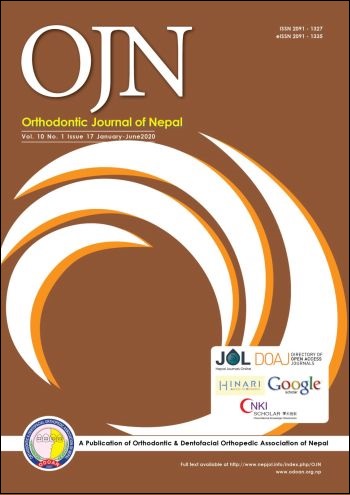Prevalence and Pattern of Canine Impaction and Its Associated Anomalies among Orthodontic Patients Attending Tertiary Care Dental Hospital in Kathmandu
DOI:
https://doi.org/10.3126/ojn.v10i1.30996Keywords:
Anomalies, Dilacerations., Impaction, Occlusion, ResorptionAbstract
Introduction: Permanent canines are considered as the cornerstone of mouth. Canines are important for esthetics and function as they are located in the anterior segment of the mouth and help in tearing of food. An impacted tooth is that tooth that cannot or will not erupt into its normal functional occlusion due to some circumstances. Those impacted tooth are considered pathologic as they might lead to various problems like resorption of roots of adjacent teeth, cystic formation, and infection with partial eruption leading to pain and trismus.
Materials & Method: All the patients (550) being treated in department of Orthodontics in Nepal Medical College from January 2017 to December 2019 were included in the study. Patients aged 13-30 years were included in the study. Clinical examinations and panoramic radiographs of patients were taken. Anterior occlusal view was done in those patients having canine impaction to determine the patterns of impaction. Data was processed in SPSS version 16.0.
Result: Among 550 orthodontic patients, 31 patients were found to have canine impaction. Among them 18 (58.1%) were females and 13 (41.9%) were males. The overall prevalence of canine impaction was found to be 5.6%. Various dental anomalies were observed in the participants’ radiographs, the most common being the retained deciduous teeth (54.8%) followed by dilacerations of adjacent teeth (51.6%). Peg shaped lateral incisors and root resorption of adjacent tooth were almost equal (22.6%) with least being the odontomas and other impacted teeth.
Conclusion: The prevalence of canine impaction in tertiary care dental hospital in Kathmandu was found to be 5.6%. Patients with impacted canines also had other dental anomalies. Knowing the prevalence of impacted canines, will encourage the community to be aware about canine impaction and educate the population about the clinical implications and the importance of performing preventive and interceptive procedures.
Downloads
Downloads
Published
How to Cite
Issue
Section
License
Copyright © held by Orthodontic & Dentofacial Orthopedic Association of Nepal
- Copyright on any research article is transferred in full to the Orthodontic & Dentofacial Orthopedic Association of Nepal upon publication in the journal. The copyright transfer includes the right to reproduce and distribute the article in any form of reproduction (printing, electronic media or any other form).
- Articles in the Orthodontic Journal of Nepal are Open Access articles published under the Creative Commons CC BY License (https://creativecommons.org/licenses/by/4.0/)
- This license permits use, distribution and reproduction in any medium, provided the original work is properly cited.




